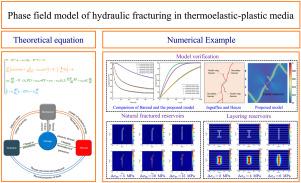热塑性介质中的水力压裂相场模型
IF 7.1
1区 工程技术
Q1 ENGINEERING, MECHANICAL
International Journal of Mechanical Sciences
Pub Date : 2024-09-27
DOI:10.1016/j.ijmecsci.2024.109750
引用次数: 0
摘要
在本研究中,我们提出了一种热力学上一致的热流体-固体-弹塑性相场模型,以准确捕捉深层页岩中水力压裂的传播过程。所建立的模型考虑了热弹塑参数的退化、应变硬化、混合模式压裂和热对流。该模型采用了非相关德鲁克-普拉格构成模型和非线性饱和应变函数,以捕捉页岩的变形行为。断裂驱动力综合了岩石的弹性能、塑性耗散能、流体能和热能的影响。该模型采用有限元离散化和牛顿-拉斐森迭代的数值计算迭代格式。为了更有效地解决耦合问题,采用了交错迭代算法来求解位移、压力、温度和相场。提取了若干数值结果,并与分析求解结果和实验测试数据进行了比较,以证明所提模型的准确性和有效性。此外,还研究了具有均质天然裂缝或分层的热弹塑性储层中水力裂缝的传播行为,结果表明该模型能够捕捉复杂的裂缝传播模式。本文章由计算机程序翻译,如有差异,请以英文原文为准。

Phase-field model of hydraulic fracturing in thermoelastic–plastic media
In this study, we present a thermodynamically consistent thermo-fluid–solid–elastic–plastic phase-field model to accurately capture the propagation process of hydraulic fracture in deep shale. The developed model takes into account the degradation of the thermoelastic–plastic parameters, strain hardening, mixed-mode fracture, and thermal convection. The model incorporates an uncorrelated Drucker–Prager constitutive model with a nonlinear saturated strain function to capture the deformation behavior of shale. The driving force of the fracture integrates the effects of elastic, plastic dissipative, fluid, and thermal energies of the rock. The model is constructed in a numerical computation iteration format using finite element discretization and Newton–Raphson iteration. To solve the coupled problem more efficiently, a staggered iteration algorithm is adopted to solve the displacement, pressure, temperature, and phase fields. Several numerical results are extracted and compared with the analytical solution results and experimental test data to demonstrate the accuracy and validity of the proposed model. In addition, the propagation behavior of hydraulic fractures in thermoelastic–plastic reservoirs with homogeneous, natural fractures or layering is investigated, and the results show that the model can capture complex fracture propagation patterns.
求助全文
通过发布文献求助,成功后即可免费获取论文全文。
去求助
来源期刊

International Journal of Mechanical Sciences
工程技术-工程:机械
CiteScore
12.80
自引率
17.80%
发文量
769
审稿时长
19 days
期刊介绍:
The International Journal of Mechanical Sciences (IJMS) serves as a global platform for the publication and dissemination of original research that contributes to a deeper scientific understanding of the fundamental disciplines within mechanical, civil, and material engineering.
The primary focus of IJMS is to showcase innovative and ground-breaking work that utilizes analytical and computational modeling techniques, such as Finite Element Method (FEM), Boundary Element Method (BEM), and mesh-free methods, among others. These modeling methods are applied to diverse fields including rigid-body mechanics (e.g., dynamics, vibration, stability), structural mechanics, metal forming, advanced materials (e.g., metals, composites, cellular, smart) behavior and applications, impact mechanics, strain localization, and other nonlinear effects (e.g., large deflections, plasticity, fracture).
Additionally, IJMS covers the realms of fluid mechanics (both external and internal flows), tribology, thermodynamics, and materials processing. These subjects collectively form the core of the journal's content.
In summary, IJMS provides a prestigious platform for researchers to present their original contributions, shedding light on analytical and computational modeling methods in various areas of mechanical engineering, as well as exploring the behavior and application of advanced materials, fluid mechanics, thermodynamics, and materials processing.
 求助内容:
求助内容: 应助结果提醒方式:
应助结果提醒方式:


